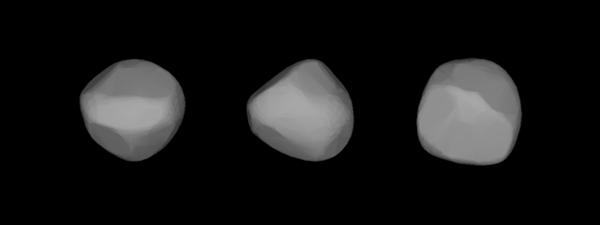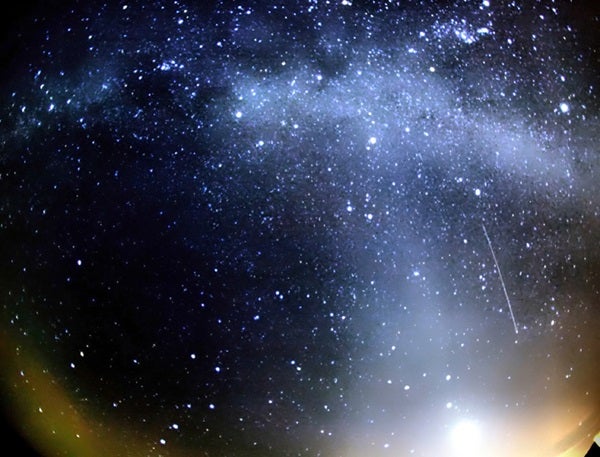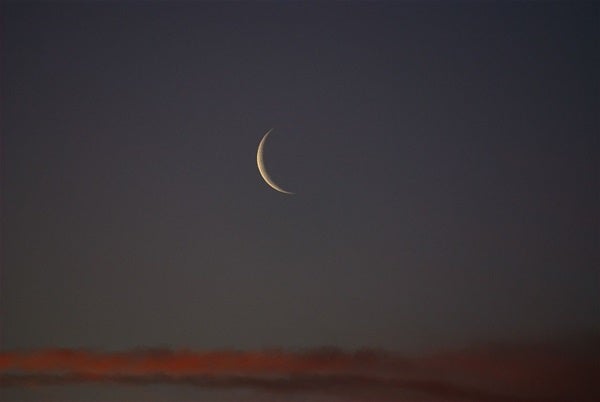Friday, July 14
The next few nights offer a wonderful opportunity to track down asteroid 6 Hebe through a telescope. The 9th-magnitude object lies in Ophiuchus the Serpent-bearer and passes just south of a pair of 6th-magnitude stars: SAO 141585 and SAO 141611. If you sketch the field tonight and then return to the same area a night or two later, you should be able to detect Hebe’s movement relative to the stellar background.
Saturday, July 15
Although Saturn reached its peak a month ago today, when it appeared opposite the Sun in the sky, our view of the ringed planet remains spectacular. It resides against the backdrop of southern Ophiuchus, a region that climbs highest in the south around 11 p.m. local daylight time. Saturn glows at magnitude 0.2 and easily outshines the background stars. When viewed through a telescope, the planet’s globe measures 18″ across and the dramatic ring system spans 41″ and tilts 27° to our line of sight.
Sunday, July 16
Last Quarter Moon occurs at 3:26 p.m. EDT. Look for it either before dawn this morning (when it looks slightly more than half-lit) or after it rises around 1 a.m. local daylight time tomorrow (when it appears as a fat crescent). Earth’s only natural satellite straddles the border between the relatively inconspicuous constellations Pisces the Fish and Cetus the Whale.
Monday, July 17
Thirty minutes after the Sun goes down, look for Mercury low in the western sky. The innermost planet lies some 8° above the horizon from mid-northern latitudes, and a bit higher if you live farther south. Mercury shines at magnitude –0.1, bright enough to show up against the twilight glow, although you shouldn’t hesitate to use binoculars if you can’t spot it immediately with your naked eye. Through a telescope, the planet appears 6″ across and about two-thirds lit.
Tuesday, July 18
Jupiter appears nearly one-third of the way to the zenith in the southwestern sky an hour after sunset this week. The brilliant planet shines at magnitude –1.9 and dominates the evening sky. It appears against the backdrop of Virgo, some 9° northwest of the Maiden’s brightest star, 1st-magnitude Spica. When viewed through a telescope, Jupiter’s disk spans 36″ and shows a wealth of atmospheric detail, while its four bright Galilean moons line up west of the planet. Conveniently, the quartet of satellites appears in order of increasing distance from the planet, with Io closest followed by Europa, Ganymede, and Callisto.
Wednesday, July 19
The Southern Delta Aquariid meteor shower ramps up this week. The shower doesn’t peak until the end of July, but you should see a few of its members in the hours before dawn. The best time to look is between 3 and 4 a.m. local daylight time, just before twilight begins. Viewing conditions should be excellent because the waning crescent Moon sheds little light into the morning sky. To tell a Southern Delta Aquariid meteor from a random dust particle burning up in Earth’s atmosphere, trace the streak of light’s path backward. A shower meteor will appear to originate from the constellation Aquarius the Water-bearer.
Thursday, July 20
Early risers should be on the lookout for this morning’s spectacular conjunction between Venus and the waning crescent Moon. The two rise around 3 a.m. local daylight time and come to dominate the eastern sky by the time twilight begins an hour later. Brilliant Venus shines at magnitude –4.1 just 3° to the upper left of the 12-percent-lit Moon. If you view the planet through a telescope this morning, it shows a 16″-diameter disk that appears 70 percent illuminated.
Friday, July 21
Perhaps no month better epitomizes summer in the Northern Hemisphere than July. And this month finds the season’s namesake asterism, the Summer Triangle, on prominent display. The trio’s brightest member, Vega in the constellation Lyra the Harp, stands nearly overhead shortly before midnight. The asterism’s second-brightest star, Altair in Aquila the Eagle, then lies more than halfway from the southeastern horizon to the zenith. Deneb, the luminary of Cygnus the Swan, marks the Summer Triangle’s third corner. Although it is this asterism’s dimmest star, it’s the brightest point of light in the northeastern sky.
The Moon reaches perigee, the closest point in its orbit around Earth, at 1:12 p.m. EDT. It then lies 224,462 miles (361,236 kilometers) from Earth’s center.
Saturday, July 22
Pluto reached the peak of its 2017 appearance last week, and it remains a tempting target for those with an 8-inch or larger telescope. The 14th-magnitude world is visible all night among the background stars of northeastern Sagittarius, some 1.8° east-southeast of 3rd-magnitude Pi (p) Sagittarii. See “In pursuit of Pluto” in the July Astronomy for complete details on finding this world.
Sunday, July 23
New Moon occurs at 5:46 a.m. EDT. At its New phase, the Moon crosses the sky with the Sun and so remains hidden by our star. But that won’t be the case the next time our satellite completes an orbit of Earth. On August 21, the New Moon will pass directly in front of our star, bringing a total solar eclipse to millions of observers across the United States from Oregon to South Carolina. The rest of the country will experience a partial eclipse, though viewers should try their best to get into the path of totality.












